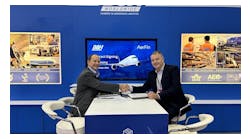DynCorp International (DI) aircraft mechanics are collaborating with NASA in an innovative training program to teach astronauts how to complete basic aircraft maintenance before taking off on space missions. The ISS Field Maintenance Training program takes place at Ellington Field in Houston, Texas, where seven U.S. astronauts as well as a few from international space agencies, have completed the more than 300 hours of aerospace vehicle and systems maintenance training.
Previously ISS mission training included less than 40 hours of maintenance training, as equipment in orbit was intended to be removed and replaced as needed. The Space Shuttle had the capability to deliver large replacement units to and from the ISS, but as the Space Shuttle era ended, ISS partners recognized a need for astronauts to increase their maintenance skills and knowledge of ISS systems and components.
Working in partnership with the United Space Alliance’s Mission Operations Directorate support team, the training program incorporates performing aviation maintenance tasks for an average of 30 to 35 hours per week on the hangar floor, specialty shops (engine, sheet metal, hydraulics), and avionics shop. The astronauts perform mechanical, hydraulic and electrical repair actions on NASA T-38 aircraft and equipment, under close supervision by many of DI’s most experienced and knowledgeable mechanics.
Learning the Tools of the Trade
Not all astronauts necessarily have backgrounds that include hands-on mechanical, electrical or tool-use experience, so the opportunity to provide instruction with a wide variety of common or specialized tools is valuable, as is the verbal instruction about tool use, troubleshooting concepts, technical data and safety.
Safety awareness is a priority in the training program and the course includes instruction of proper safety equipment use, arrangement of workspace, cautions with electrostatic discharge or soldering risks, the urgency of controlling foreign object debris, and tool control processes.
With the DI mechanics’ guidance trainees will complete dozens of maintenance tasks such as canopy seal leak repair, removal and replacement of gear boxes, remanufacturing of strobe lights from the board up, removal and replacement of engines, inspection and rebuilding of brake master cylinders, and replacement of nose wheel steering actuators.
The astronauts are also trained on applicable back shop maintenance functions such as pin-out and assembly of military standard connectors, avionics troubleshooting, wire harness continuity and voltage troubleshooting, star pattern torque application, torque wrench setting and care and installation of helicoil inserts for fastener interfaces.
A Rewarding Experience
“It was quite gratifying to witness the rapport that immediately developed between our mechanics and the astronauts,” commented DynCorp International executive manager Jim Snowden. “Very few aircraft mechanics in the world will ever have this opportunity.”
Snowden, who previously served with the NASA Astronaut Office knew this would be an incredibly rewarding experience. “Our team members feel much more connected to ISS missions and will be watching the results of their contributions in action as ‘their’ astronauts live and work 250 miles above the earth.”


